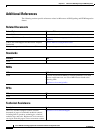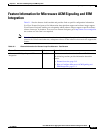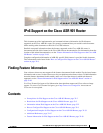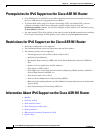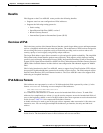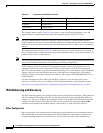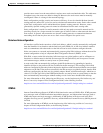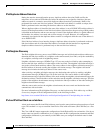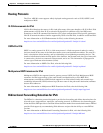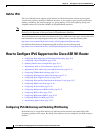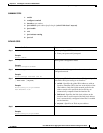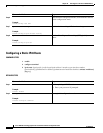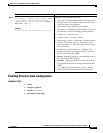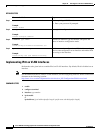
32-5
Cisco ASR 901 Series Aggregation Services Router Software Configuration Guide
OL-23826-09
Chapter 32 IPv6 Support on the Cisco ASR 901 Router
Information About IPv6 Support on the Cisco ASR 901 Router
provides more control over the network but it requires more work to maintain the table. The table must
be updated every time routes are added or changed. Moreover, the static routes must be manually
reconfigured if there is a change in the network topology.
Static configuration provides security and resource efficiency. It uses less bandwidth than dynamic
routing protocols and no CPU cycles are used to calculate and communicate routes. Static routes created
by the static configuration can be redistributed into dynamic routing protocols. However, routes
generated by dynamic routing protocols cannot be redistributed into the static routing table.
Static configuration is useful for smaller networks with only one path to an outside network and in
providing security for a larger network for certain types of traffic or links to other networks that need
more control. In general, most networks use dynamic routing protocols to communicate between
networking devices but may have one or two static routes configured for special cases.
Stateless Autoconfiguration
All interfaces on IPv6 nodes must have a link-local address, which is usually automatically configured
from the identifier for an interface and the link-local prefix FE80::/10. A link-local address enables a
node to communicate with other nodes on the link and can be used to further configure the node.
Nodes can connect to a network and automatically generate global IPv6 addresses without the need for
manual configuration or help of a Dynamic Host Configuration Protocol (DHCP) server.
With IPv6, a router on the link advertises in RA messages any global prefixes, and its willingness to
function as a default router for the link. RA messages are sent periodically and in response to router
solicitation messages, which are sent by hosts at system startup.
A node on the link can automatically configure global IPv6 addresses by appending its interface
identifier (64 bits) to the prefixes (64 bits) included in the RA messages. The resulting 128-bit IPv6
addresses configured by the node are then subjected to duplicate address detection (DAD) to ensure their
uniqueness on the link. If the prefixes advertised in the RA messages are globally unique, then the IPv6
addresses configured by the node are also globally unique. Router solicitation messages, which have a
value of 133 in the Type field of the ICMP packet header, are sent by hosts at system startup so that the
host can immediately autoconfigure without needing to wait for the next scheduled RA message.
For more information on IPv6 Addressing and Discovery, see the Implementing IPv6 Addressing and
Basic Connectivity chapter of IPv6 Configuration Guide, at the following location:
http://www.cisco.com/en/US/docs/ios-xml/ios/ipv6/configuration/15-2mt/ip6-addrg-bsc-con.html
ICMPv6
Internet Control Message Protocol (ICMP) in IPv6 functions the same as ICMP in IPv4. ICMP generates
error messages such as ICMP destination unreachable messages, and informational messages such as
ICMP echo request and reply messages. Additionally, ICMP packets in IPv6 are used in the IPv6
neighbor discovery process, path MTU discovery, and the Multicast Listener Discovery (MLD) protocol
for IPv6.
For more information on ICMPv6, see the Implementing IPv6 Addressing and Basic Connectivity
chapter of IPv6 Configuration Guide, at the following location:
http://www.cisco.com/en/US/docs/ios-xml/ios/ipv6/configuration/15-2mt/ip6-addrg-bsc-con.html




